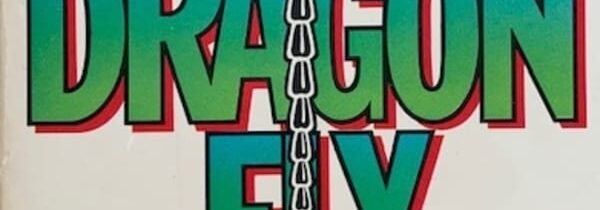THROWBACK THURSDAY: DRAGONFLY by K. R. Dwyer (Dean Koontz) (1975)

Online conspiracy theorists have been quick to claim that American author Dean Koontz predicted the COVID-19 outbreak back in 1981, on the basis of his novel The Eyes of Darkness which featured a Chinese manufactured virus called “Wuhan-400”. The links between the virus in the book and the current pandemic, however, are very slight.
The Eyes of Darkness, however, was not the first time that Koontz wrote about a deadly virus with a Chinese connection. In the 1975 novel Dragonfly, which he wrote under the K. R. Dwyer nom de plume, Koontz postulated a reverse scenario to that in The Eyes of Darkness, with a plot by a rogue CIA group to unleash a deadly virus in China.
The basic premise of Dragonfly is that a powerful group of far right American businessmen and government officials have concocted a plan, code named Dragonfly, to bring China to its knees. During a visit to America a Chinese national was temporarily kidnapped, hypnotised and had a small capsule inserted in his shoulder. In the capsule is a deadly virus designed to bring down the Chinese elite without destroying the whole country. Upon hearing a trigger phrase, the unwitting carrier will break the capsule and unleash the virus, killing thousands and allowing a pro-Western group to take over the Chinese Government.
When the new reformist head of the CIA, Robert McAlister, learns of the plot he dispatches a hardened former agent, David Canning, and an attractive Asian operative to China to help the Chinese intercept the unknown carrier. Meanwhile McAlister tries to shutdown the powerful architects of the plot, known as The Committeeman, before they seize full control of America.
At its core, Dragonfly is a typical 1970’s conspiracy thriller, with its idea of a secret, powerful cabal of “fanatical anti-Communists” with connections to “extreme right-wing paramilitary groups” and wealthy “patrons in New York banking and Texas oil.” Responsible for the Kennedy assassination this group now plans to destroy the Chinese government and cement its power in America.
After a lengthy exposition on the Committeemen and the mechanics of the Dragonfly plan, the book kicks into gear, with Canning dodging various assassination attempts on his way to China and McAlister desperately trying to work out who is running the Committeeman operation in Washington. The pace picks up over the final fifty pages or so and there are a couple of good twists as the book nears its twin climaxes in Washington and Beijing.
I remembered enjoying Dragonfly when I first read it back in the early 1980’s and it has held up reasonably well over the years. The central premise of having to identify an unknown and unwitting carrier is quite clever and Koontz makes good use of the twin investigations by McAlister and Canning to maximise the suspense. The technical detail around the virus and its activation still seems sufficiently credible, and there is enough action to keep the story interesting. There is also a good intricacy to the plot and Koontz’s musings on 1970’s politics still resonates today.
On the negative side, the characterisations are typical of many 1970’s conspiracy thrillers and are not very subtle or well fleshed out. The resolution of the book’s Washington strand is also a little weak, with things falling into place for McAlister because of the crazed behaviour of the Committeemen’s mole. I suspect that if Dean Koontz was writing it now, it would be a much more polished piece of fiction with less exposition and clunky 1970’s styled sex scenes and more suspense.
Overall, I quite enjoyed Dragonfly and was glad that I re-read it.
Three and a half to four stars out of five!
The cover on the 1979 Sphere edition of Dragonfly is quite solid and typical of many early 1980’s thrillers, but lacks the sense of drama and action of the 1976 Ballantine paperback edition below:



How very balanced of Dean Koontz! I’m almost tempted to read ‘Dragonfly’ for entirely inappropriate reasons 😉